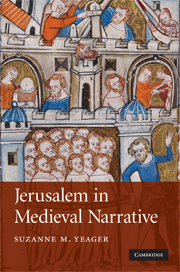Book contents
- Frontmatter
- Contents
- Acknowledgments
- List of abbreviations
- Introduction: texts and contexts
- 1 Pilgrimage to Jerusalem: three accounts by English authors
- 2 Craving heritage: portrayals of Richard I and the English quest for Jerusalem in Richard, Coer de Lyon
- 3 The crusade of the soul in The Siege of Jerusalem
- 4 The Book of Sir John Mandeville: text of pilgrimage and spiritual reform
- 5 Beyond the Celestial and Terrestrial Jerusalem: the Promised Land in western Christendom
- Conclusion
- Notes
- Bibliography
- Index
- CAMBRIDGE STUDIES IN MEDIEVAL LITERATURE
4 - The Book of Sir John Mandeville: text of pilgrimage and spiritual reform
Published online by Cambridge University Press: 22 September 2009
- Frontmatter
- Contents
- Acknowledgments
- List of abbreviations
- Introduction: texts and contexts
- 1 Pilgrimage to Jerusalem: three accounts by English authors
- 2 Craving heritage: portrayals of Richard I and the English quest for Jerusalem in Richard, Coer de Lyon
- 3 The crusade of the soul in The Siege of Jerusalem
- 4 The Book of Sir John Mandeville: text of pilgrimage and spiritual reform
- 5 Beyond the Celestial and Terrestrial Jerusalem: the Promised Land in western Christendom
- Conclusion
- Notes
- Bibliography
- Index
- CAMBRIDGE STUDIES IN MEDIEVAL LITERATURE
Summary
Having begun this study with English pilgrim itineraries, this chapter, at first, appears to be a return to a similar subject. However, The Book of Sir John Mandeville represents a contribution to pilgrimage and crusade writing unlike any before its time. The Book's unique qualities arise from its composition from more than fifty sources, ranging from romances to itineraries and military histories. Through this compilation, the writer presents an elaborate narrative in the guise of a guidebook to Jerusalem and beyond. For as many textual genera as the Book includes, it seems to have been used by its medieval audiences for just as many purposes, including pleasure reading, didactic instruction, fulfillment of curiosity, and vicarious pilgrimage, to name only a few. Josephine Waters Bennett, for instance, says that the Book was intended as “entertainment for wouldbe crusaders,” an aid to pilgrims, and an encouragement for the preservation of holy places. Some scholars believe that it was composed in order to promote crusade interests, particularly those at Nicopolis. It was also heeded as a serious work of scientific import, studied by writers and navigators such as Christopher Columbus, Thomas More, Walter Raleigh, Martin Frobisher, Gerhard Mercator, and others. For the Book's many uses and audiences, Iain Macleod Higgins has referred to the work as a medieval “multi-text.” More recently, Geraldine Heng has noted how the Book's narrative format functions like a “bricolage of exotica,” a “wonder box,” and “curiosity cabinet” for the variety of experiences it makes available.
- Type
- Chapter
- Information
- Jerusalem in Medieval Narrative , pp. 108 - 134Publisher: Cambridge University PressPrint publication year: 2008



